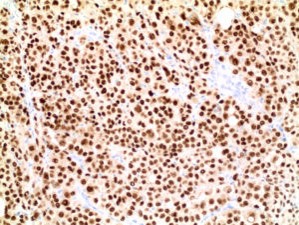SOX10 by IHC
SOX10 by IHC-12376 - Technical only, 12379 - Technical & interpretation
SOX10 by IHC
12376 - Technical only, 12379 - Technical & interpretation
LAB12376
LAB12379
LAB12379
- All IHC stains will include a positive control tissue
- SOX10has been reported to be highly sensitive (97-100%) for both primary and metastatic melanomas, and is expressed in all subtypes
- SOX10 is more sensitive and specific for desmoplastic melanoma than S100; it can help distinguish melanoma from background scar tissue
- In tumors, it labels melanoma and tumors of neural crest origin such as Schawwn cell tumors, and glial cells
- This marker is also expressed in clear cell sarcomas and peripheral nerve sheath tumors and is absent in angiomyolipomas
- SOX10is present in both luminal and positive tumors include acinic cell, adenoid cystic, epithelial-myoepithelial and myoepithelial, carcinomas and pleomorphic adenomas. In contrast, salivary duct, mucoepidermoid, oncocytic and squamous cell carcinomas are SOX10 negative, as are Warthin tumors
- This marker has been reported in basal like breast cancers
- Rare examples of squamous cell carcinomas of the head and neck and pulmonary small cell carcinomas have been reported to stain for this marker
- Pathologists should consider if entrapped non-neoplastic Schwann cells or melanocytes are present before diagnosing a SOX10 positive tumor
Tissue
Submit a formalin-fixed, paraffin embedded tissue block
Formalin-fixed, paraffin embedded (FFPE) tissue block
FFPE tissue section mounted on a charged, unstained slide
Ambient (preferred)
- Unlabeled/mislabeled block
- Insufficient tissue
- Slides broken beyond repair
AHL - Immunohistochemistry
Mo - Fr
1 - 2 days
Immunohistochemical staining and microscopic examination
If requested, an interpretive report will be provided
Specifications
- SOX10 is a member of the SOX family of transcription factors involved in regulation of embryonic development and cell fate
- It is expressed in cells of schwannian and melanocytic lineages, and thus is a marker for schwannian and melanocytic tumors of skin and soft tissue
- It is also a useful marker for myoepithelial and basal cell neoplasms
Staining pattern
- Nuclear staining
References
- ZHU S et al: Review and Updates of Immunohistochemistry in Selected Salivary Gland and Head and Neck Tumors. Arch Pathol Lab Med. 2015;139:55-66).
- Miettinen M et al: SOX10-A marker for not only schwannian and melanocytic neoplasms but also myoepithelial cell tumors of soft tissue; a systematic analysis of 5134 tumors. Am J Surg Pathol 2015;00:000-000.
- Ordonez N. Value of SOX10 immunostaining in tumor diagnosis. Adv Anat Pathol. 2013;20:275-283.
- Ordonez N: Value of melanocytic-associated immunohistochemical markers in the diagnosis of malignant melanoma; a review and update. Hum Pathol 45; 191-205, 2014.
88342 - 1st stain
88341 - each additional stain
88341 - each additional stain
09/06/2017
10/17/2018
01/12/2024
